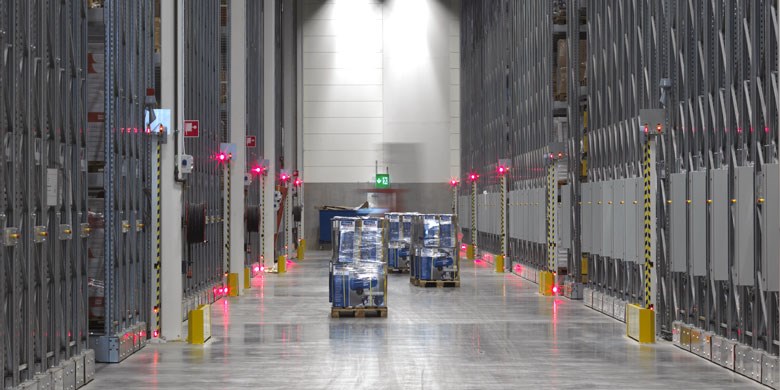Optimizing space in a cold storage warehouse is essential for maximizing storage capacity, improving operational efficiency, and reducing costs. With perishable goods requiring specific temperature conditions, efficient space utilization becomes even more critical. This article explores effective strategies to optimize space in a cold storage warehouse, ensuring efficient storage and retrieval of temperature-sensitive products.
- Utilize Vertical Space
1.1 High-Stacking Racks
- Maximize Height: Invest in high-stacking racks that allow you to utilize vertical space efficiently, making use of the warehouse’s full height.
- Adjustable Height: Choose racks with adjustable heights to accommodate products of varying sizes and optimize storage capacity.
1.2 Mezzanine Platforms
- Additional Storage: Install mezzanine platforms to create additional storage space above ground level, particularly for lighter and smaller items.
- Multi-Level Storage: Utilize multi-level mezzanine structures to maximize vertical space without expanding the warehouse footprint.
- Implement Efficient Storage Systems
2.1 Pallet Racking Systems
- Selective Racking: Use selective pallet racking systems to store products of different sizes and SKUs, allowing for easy access and retrieval.
- Drive-In Racking: Implement drive-in racking for high-density storage of homogeneous products, optimizing space by minimizing aisles.
2.2 Mobile Racking Systems
- Space-Saving Design: Mobile racking systems utilize movable shelves that compact together when not in use, maximizing space utilization.
- Flexibility: These systems can be configured to accommodate various product sizes and optimize aisle space based on demand.
- Optimize Aisle Widths
3.1 Narrow Aisle Layout
- Maximize Storage: Adopt a narrow aisle layout to maximize storage capacity by reducing aisle widths while still allowing forklift access.
- Guidance Systems: Implement guidance systems such as wire-guided or laser-guided technology to ensure safe and efficient movement within narrow aisles.
3.2 Very Narrow Aisle (VNA) Systems
- High-Density Storage: VNA systems utilize narrow aisles and specialized forklifts to achieve high-density storage, maximizing space utilization.
- Automated Solutions: Consider automated VNA systems for increased efficiency and throughput in cold storage warehouses.
- Optimal Picking Strategies
4.1 Zone Picking
- Efficient Order Fulfillment: Implement zone picking strategies to divide the warehouse into zones and assign specific products to each zone, streamlining order picking processes.
- Reduced Travel Time: By reducing the distance traveled by pickers, zone picking minimizes time and energy consumption.
4.2 Batch Picking
- Consolidated Orders: Batch picking involves picking multiple orders simultaneously, optimizing picking routes and minimizing travel time.
- Increased Throughput: Batch picking increases order fulfillment rates and reduces labor costs by maximizing picker productivity.
- Invest in Automated Storage and Retrieval Systems (AS/RS)
5.1 AS/RS for Cold Storage
- High-Density Storage: AS/RS systems utilize automated cranes to retrieve and store pallets in dense configurations, maximizing space utilization.
- Temperature Control: Automated systems ensure precise temperature control during storage and retrieval, maintaining product integrity.
5.2 Shuttle Systems
- Efficient Storage: Shuttle systems use robotic shuttles to transport pallets within racking structures, optimizing space and throughput.
- Dynamic Storage: Shuttle systems adapt to changing inventory levels and demand patterns, ensuring efficient storage and retrieval operations.
- Optimize Cold Room Layout
6.1 Zone Segregation
- Temperature Zones: Segregate cold rooms into temperature zones based on product requirements, ensuring optimal conditions for different types of perishable goods.
- Temperature Mapping: Conduct temperature mapping studies to identify areas with temperature variations and optimize cold room layout accordingly.
6.2 Efficient Packing and Stacking
- Compact Packing: Train staff to pack and stack products efficiently, maximizing available space within cold rooms while maintaining proper airflow.
- Uniform Stacking: Ensure uniform stacking of pallets to prevent air gaps and optimize space utilization in cold storage areas.
- Regular Space Audits and Optimization
7.1 Continuous Improvement
- Regular Assessments: Conduct regular space audits to identify inefficiencies and opportunities for optimization in cold storage operations.
- Continuous Monitoring: Monitor space utilization metrics and key performance indicators (KPIs) to track progress and drive continuous improvement efforts.
7.2 Flexibility and Adaptability
- Dynamic Layouts: Design warehouse layouts with flexibility in mind, allowing for easy reconfiguration to accommodate changing inventory profiles and storage needs.
- Adaptive Technologies: Embrace new technologies and innovations that enhance space optimization and adapt to evolving business requirements.
Optimizing space in a cold storage warehouse is essential for maximizing storage capacity, improving operational efficiency, and reducing costs. By utilizing vertical space, implementing efficient storage systems, optimizing aisle widths, adopting optimal picking strategies, investing in automated storage and retrieval systems, optimizing cold room layouts, and conducting regular space audits, cold storage facilities can achieve optimal space utilization and enhance overall performance. As the demand for cold storage continues to grow, implementing these strategies becomes increasingly important for ensuring the efficient storage and handling of temperature-sensitive products in the global supply chain.


 Dave McGowan has been a member of the WEL Family since May 1989. He is a husband and father of two children. Dave is also a U.S. Army veteran and served in Vietnam in 1971-1972, and he attended driving school soon after he was released from the military in 1974.
Dave McGowan has been a member of the WEL Family since May 1989. He is a husband and father of two children. Dave is also a U.S. Army veteran and served in Vietnam in 1971-1972, and he attended driving school soon after he was released from the military in 1974. During his career with WEL, Phil has worked as a driver, dispatcher, terminal manager and customer service manager. He says he always was a driver first, though non-driving jobs taught him financial management that helps him as an owner-operator.
During his career with WEL, Phil has worked as a driver, dispatcher, terminal manager and customer service manager. He says he always was a driver first, though non-driving jobs taught him financial management that helps him as an owner-operator.